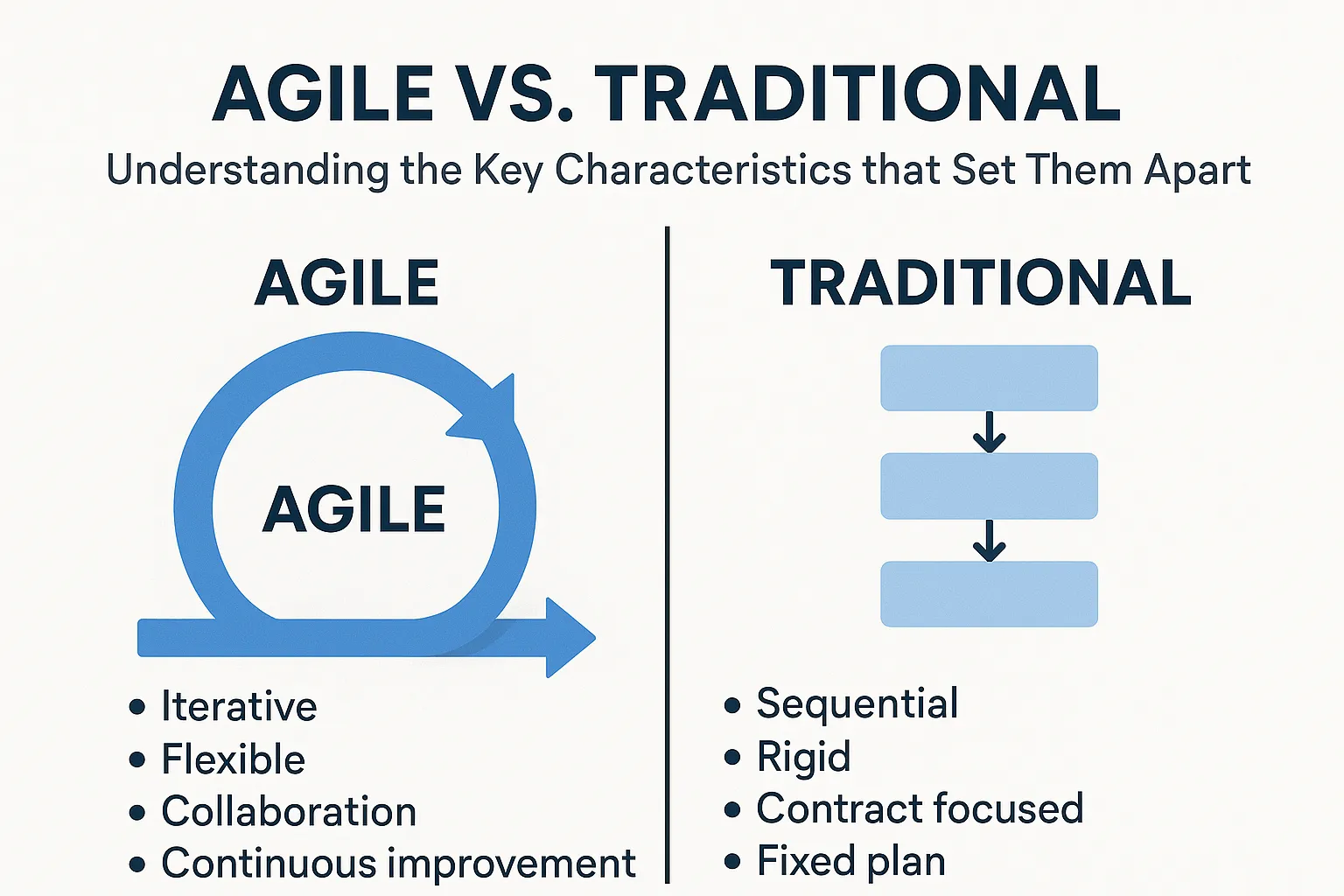Introduction
Project management is a critical discipline that involves planning, executing, and overseeing projects to achieve specific goals within defined constraints such as time, budget, and resources. Its significance spans across various industries, including construction, information technology, healthcare, and marketing, where effective project management can lead to successful outcomes, improved efficiency, and enhanced stakeholder satisfaction.
In project management, two predominant methodologies have emerged: agile and traditional (often referred to as waterfall). Each approach has its unique characteristics, processes, and philosophies that cater to different project needs and environments.
Agile Project Management
Agile project management is characterized by its iterative and incremental approach, emphasizing flexibility, collaboration, and customer feedback. Agile methodologies, such as Scrum and Kanban, prioritize adaptive planning and encourage teams to respond to changes quickly, making it particularly suitable for projects in dynamic environments where requirements may evolve over time.
Traditional Project Management
In contrast, traditional project management follows a linear and sequential process, where each phase of the project must be completed before moving on to the next. This approach is often structured around a detailed project plan, with a strong focus on documentation and adherence to predefined timelines and budgets. Traditional methodologies are well-suited for projects with clear, stable requirements and where changes are minimal.
Relevance of Comparison
Understanding the key characteristics that set agile and traditional project management apart is essential for project managers and students alike. By comparing and contrasting these two methodologies, professionals can better assess which approach aligns with their project goals, team dynamics, and stakeholder expectations. This knowledge not only enhances decision-making but also fosters a more adaptable mindset in managing projects across various contexts.
Overview of Traditional Project Management
Traditional project management, often exemplified by the waterfall model, is characterized by a structured and linear approach to project execution. This methodology has been widely adopted across various industries and is particularly effective for projects with well-defined requirements and low levels of uncertainty. Below are the key characteristics that define traditional project management:
- Waterfall Model and Linear Approach: The waterfall model is a sequential design process where progress flows in one direction—downwards through distinct phases such as conception, initiation, analysis, design, construction, testing, and maintenance. Each phase must be completed before the next one begins, making it a linear approach that emphasizes a clear path from start to finish. This model is beneficial for projects where requirements are unlikely to change, allowing for a straightforward progression through the project lifecycle.
- Importance of Upfront Planning and Documentation: In traditional project management, extensive upfront planning is crucial. This involves detailed documentation of project requirements, timelines, and deliverables before any work begins. The emphasis on documentation ensures that all stakeholders have a clear understanding of the project scope and objectives, which helps in minimizing misunderstandings and scope creep later in the project. This thorough planning phase is essential for setting expectations and aligning the project team with the project goals.
- Role of Project Managers as Primary Decision-Makers: In traditional project management, project managers hold a central role as the primary decision-makers. They are responsible for planning, executing, and closing projects, and they often have the authority to make critical decisions regarding resource allocation, timelines, and project direction. This centralized decision-making can streamline processes and provide clear leadership, but it may also limit input from team members and stakeholders, potentially stifling innovation and adaptability.
- Measuring Success through Adherence to Scope, Time, and Budget: Success in traditional project management is typically measured by how well the project adheres to its predefined scope, timeline, and budget. This triple constraint—often referred to as the project management triangle—serves as a benchmark for evaluating project performance. Projects are considered successful if they are completed on time, within budget, and according to the specified requirements. This focus on strict adherence to these parameters can lead to a more predictable outcome but may also result in challenges when unexpected changes arise.
Overview of Agile Project Management
Agile project management is a dynamic and iterative approach that emphasizes flexibility, collaboration, and customer satisfaction. Unlike traditional project management methodologies, which often follow a linear and sequential process, agile methodologies allow teams to adapt to changes and continuously improve their work throughout the project lifecycle. Below are the key characteristics that define agile project management:
Definition and Iterative Nature
- Agile Methodology: Agile is a project management approach that focuses on delivering small, incremental changes to a product or service. It is characterized by short development cycles known as iterations or sprints, which typically last from one to four weeks. This iterative nature allows teams to refine their work based on feedback and changing requirements, ensuring that the final product aligns closely with customer needs and expectations.
Importance of Collaboration and Flexibility
- Collaboration: Agile methodologies prioritize collaboration among team members and stakeholders. Regular communication through daily stand-ups, sprint reviews, and retrospectives fosters a culture of transparency and collective problem-solving. This collaborative environment enables teams to respond quickly to challenges and opportunities, enhancing overall project outcomes.
- Flexibility: One of the core principles of agile is its inherent flexibility. Agile teams are encouraged to embrace change, whether it comes from evolving customer requirements or market conditions. This adaptability allows teams to pivot and adjust their strategies without derailing the entire project, a stark contrast to traditional methods that often resist change.
Role of Cross-Functional Teams and Stakeholders
- Cross-Functional Teams: Agile project management relies on cross-functional teams that bring together diverse skill sets and perspectives. These teams are typically self-organizing, meaning they have the autonomy to make decisions and manage their work without heavy oversight. This structure not only enhances creativity and innovation but also accelerates the decision-making process.
- Stakeholder Involvement: Stakeholders play a crucial role in agile projects. Their continuous involvement ensures that the project remains aligned with business goals and customer expectations. Regular feedback loops allow stakeholders to provide input at various stages, which helps in refining the product and making informed decisions.
Measuring Success through Customer Satisfaction and Adaptive Planning
- Customer Satisfaction: In agile project management, success is primarily measured by customer satisfaction. The focus is on delivering value to the customer through high-quality products that meet their needs. Agile teams often use customer feedback to gauge satisfaction and make necessary adjustments, ensuring that the end product is not only functional but also desirable.
- Adaptive Planning: Agile methodologies emphasize adaptive planning, which involves revisiting and revising plans based on ongoing feedback and project developments. This approach contrasts with traditional project management, where detailed plans are often set in stone at the beginning of the project. Agile teams regularly assess their progress and adjust their plans to better align with customer needs and project goals.
Comparison of Agile and Traditional Project Management
Agile and Traditional methodologies represent two distinct approaches, each with its own set of characteristics that cater to different project needs and environments. Understanding these differences is crucial for project managers and students alike, as it can significantly influence project outcomes. Below, we explore key dimensions where Agile and Traditional project management diverge.
1. Planning Approaches: Predictive vs. Adaptive
- Traditional Project Management: This methodology typically follows a predictive planning approach, where project scope, timelines, and resources are defined upfront. The project is planned in detail before execution begins, often using a linear progression through phases such as initiation, planning, execution, monitoring, and closure. This approach is beneficial for projects with well-defined requirements and low uncertainty.
- Agile Project Management: In contrast, Agile employs an adaptive planning approach. It embraces change and allows for iterative development, where project requirements and solutions evolve through collaboration. Agile teams work in short cycles (sprints), enabling them to reassess priorities and adapt plans based on feedback and changing circumstances. This flexibility is particularly advantageous in dynamic environments where requirements may shift frequently.
2. Team Structures and Roles
- Traditional Project Management: Teams are often structured hierarchically, with clearly defined roles and responsibilities. Project managers typically hold significant authority and are responsible for decision-making, while team members execute tasks as directed. This structure can lead to a more controlled environment but may stifle creativity and responsiveness.
- Agile Project Management: Agile promotes a more collaborative and cross-functional team structure. Roles are often fluid, with team members encouraged to take on multiple responsibilities. The emphasis is on self-organizing teams that work collaboratively to achieve project goals. This structure fosters innovation and allows for quicker responses to challenges, as team members are empowered to make decisions collectively.
3. Stakeholder Involvement and Communication Styles
- Traditional Project Management: Stakeholder involvement is typically more limited and occurs primarily at the beginning and end of the project. Communication tends to be formal, with structured meetings and reports. This can create a disconnect between stakeholders and the project team, as feedback may not be integrated until later stages.
- Agile Project Management: Agile methodologies prioritize continuous stakeholder involvement throughout the project lifecycle. Regular communication is facilitated through daily stand-ups, sprint reviews, and retrospectives, ensuring that stakeholders are engaged and their feedback is incorporated in real-time. This ongoing dialogue enhances transparency and alignment, leading to better project outcomes.
4. Handling Changes and Risks
- Traditional Project Management: Changes in scope or requirements are often viewed as risks that need to be managed carefully. The traditional approach typically involves a formal change control process, which can slow down project progress and lead to resistance from stakeholders. Risk management is often reactive, addressing issues as they arise rather than anticipating them.
- Agile Project Management: Agile embraces change as a natural part of the project process. It encourages teams to be proactive in identifying potential risks and adapting their plans accordingly. Agile methodologies incorporate regular reviews and adjustments, allowing teams to pivot quickly in response to new information or changing market conditions. This proactive stance on risk management fosters resilience and adaptability.
Advantages and Disadvantages of Each Approach
Both agile and traditional methodologies offer distinct advantages and disadvantages that can significantly impact project outcomes. Understanding these characteristics is crucial for project managers and students alike, as it allows for informed decision-making based on project needs and contexts.
Advantages of Traditional Project Management
- Stability and Predictability: Traditional project management, often characterized by a linear and sequential approach, provides a clear structure and timeline. This predictability is beneficial for projects with well-defined requirements and scope, allowing for easier tracking of progress and resource allocation.
- Comprehensive Documentation: Traditional methodologies emphasize thorough documentation at every stage of the project. This ensures that all stakeholders have access to detailed records, which can be invaluable for future reference and compliance purposes.
- Defined Roles and Responsibilities: In traditional project management, roles and responsibilities are clearly defined. This clarity helps in minimizing confusion and ensures that team members understand their specific contributions to the project.
- Risk Management: Traditional approaches often include extensive risk management plans developed during the initial phases. This proactive stance can help identify potential issues early on, allowing for mitigation strategies to be put in place.
Advantages of Agile Project Management
- Flexibility and Adaptability: Agile project management is inherently flexible, allowing teams to adapt to changes in project scope or requirements quickly. This responsiveness is particularly advantageous in dynamic environments where client needs may evolve.
- Enhanced Collaboration: Agile methodologies promote continuous collaboration among team members and stakeholders. Regular meetings, such as daily stand-ups and sprint reviews, foster open communication and ensure that everyone is aligned with project goals.
- Faster Delivery of Value: Agile focuses on delivering small, incremental improvements, which means that stakeholders can see results more quickly. This iterative approach allows for faster feedback and adjustments, ultimately leading to a more refined final product.
- Customer-Centric Approach: Agile methodologies prioritize customer satisfaction by involving clients throughout the project lifecycle. This engagement ensures that the final product aligns closely with customer expectations and needs.
Potential Drawbacks of Each Methodology
Traditional Project Management Drawbacks:
- Inflexibility: The rigid structure of traditional project management can make it difficult to accommodate changes once the project is underway. This inflexibility can lead to challenges if unexpected issues arise or if client needs shift.
- Longer Time to Market: Due to its sequential nature, traditional project management may result in longer timelines before delivering the final product, which can be a disadvantage in fast-paced industries.
Agile Project Management Drawbacks:
- Less Predictability: The iterative nature of agile can lead to uncertainty regarding project timelines and deliverables. This unpredictability can be challenging for stakeholders who prefer a more structured approach.
- Documentation Challenges: While agile emphasizes working software over comprehensive documentation, this can sometimes lead to insufficient records, making it difficult to track decisions and changes over time.
When to Use Agile vs. Traditional Project Management
Choosing the right methodology is crucial for the success of any project. Both Agile and Traditional (often referred to as Waterfall) project management styles have distinct characteristics that make them suitable for different types of projects. Understanding these characteristics can help project managers make informed decisions about which approach to adopt.
Characteristics Favoring Traditional Project Management
Traditional project management is often best suited for projects that exhibit the following characteristics:
- Well-Defined Scope: Projects with clear, fixed requirements and deliverables benefit from a structured approach. Traditional methods excel in environments where changes are minimal and the project scope is well understood from the outset.
- Predictable Outcomes: When the project outcomes can be anticipated with a high degree of certainty, traditional management provides a reliable framework for planning and execution. This is particularly true in industries like construction or manufacturing, where processes are standardized.
- Regulatory Compliance: Projects that must adhere to strict regulatory standards or compliance requirements often necessitate a traditional approach. The sequential nature of traditional project management allows for thorough documentation and review processes that are essential in regulated environments.
- Limited Stakeholder Involvement: In scenarios where stakeholder engagement is minimal or where decision-making is centralized, traditional project management can streamline processes and reduce the complexity of communication.
Example Projects: Construction projects, manufacturing processes, and software development with fixed requirements (e.g., government contracts) are typically well-suited for traditional project management.
Characteristics Favoring Agile Project Management
Agile project management, on the other hand, is ideal for projects that demonstrate the following traits:
- Dynamic and Evolving Requirements: Projects that are subject to frequent changes or where requirements are not fully known at the start benefit from Agile’s flexibility. Agile methodologies allow teams to adapt to changes quickly and efficiently.
- High Stakeholder Engagement: Agile thrives in environments where continuous stakeholder feedback is essential. Regular interactions with stakeholders help ensure that the project aligns with their needs and expectations.
- Innovation and Creativity: Projects that require innovative solutions or creative problem-solving are often better suited for Agile methodologies. The iterative nature of Agile encourages experimentation and rapid prototyping.
- Cross-Functional Teams: Agile methodologies work well in environments where teams are composed of members with diverse skills who can collaborate closely. This collaborative approach fosters communication and enhances team dynamics.
Example Projects: Software development projects, product design initiatives, and marketing campaigns that require rapid iteration and feedback are typically well-suited for Agile project management.
Conclusion
Understanding the distinctions between agile and traditional methodologies is crucial for project managers and students alike. Each approach has its unique characteristics that cater to different project needs and environments. Here’s a recap of the key characteristics that set them apart:
- Structure vs. Flexibility: Traditional project management, often characterized by a linear and sequential approach, emphasizes detailed planning and strict adherence to timelines. In contrast, agile methodologies prioritize flexibility and adaptability, allowing teams to respond to changes and evolving project requirements more effectively.
- Customer Collaboration vs. Contract Negotiation: Agile methodologies foster continuous collaboration with stakeholders and customers throughout the project lifecycle, ensuring that the final product aligns closely with user needs. Traditional methods, however, often focus on contract negotiations and predefined specifications, which can limit responsiveness to customer feedback.
- Incremental Delivery vs. Full Delivery: Agile promotes incremental delivery of project components, enabling teams to release functional parts of the project regularly. This approach allows for early detection of issues and adjustments based on user feedback. Traditional project management typically aims for a single, comprehensive delivery at the end of the project, which can lead to longer timelines and potential misalignment with user expectations.
- Team Empowerment vs. Hierarchical Control: Agile methodologies encourage self-organizing teams that are empowered to make decisions, fostering a culture of collaboration and innovation. In contrast, traditional project management often relies on a more hierarchical structure, where decisions are made at higher levels, potentially stifling creativity and responsiveness.
Find out more about Shaun Stoltz https://www.shaunstoltz.com/about/.
This post was written by an AI and reviewed/edited by a human.



